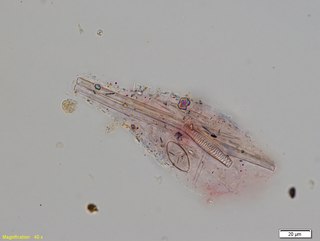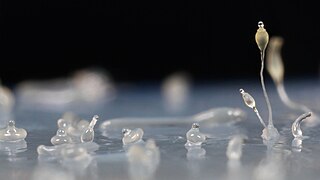
Amoebozoa is a major taxonomic group containing about 2,400 described species of amoeboid protists, often possessing blunt, fingerlike, lobose pseudopods and tubular mitochondrial cristae. In traditional classification schemes, Amoebozoa is usually ranked as a phylum within either the kingdom Protista or the kingdom Protozoa. In the classification favored by the International Society of Protistologists, it is retained as an unranked "supergroup" within Eukaryota. Molecular genetic analysis supports Amoebozoa as a monophyletic clade. Modern studies of eukaryotic phylogenetic trees identify it as the sister group to Opisthokonta, another major clade which contains both fungi and animals as well as several other clades comprising some 300 species of unicellular eukaryotes. Amoebozoa and Opisthokonta are sometimes grouped together in a high-level taxon, variously named Unikonta, Amorphea or Opimoda.

Lobosa is a taxonomic group of amoebae in the phylum Amoebozoa. Most lobosans possess broad, bluntly rounded pseudopods, although one genus in the group, the recently discovered Sapocribrum, has slender and threadlike (filose) pseudopodia. In current classification schemes, Lobosa is a subphylum, composed mainly of amoebae that have lobose pseudopods but lack cilia or flagella.

Amorphea is a taxonomic supergroup that includes the basal Amoebozoa and Obazoa. That latter contains the Opisthokonta, which includes the Fungi, Animals and the Choanomonada, or Choanoflagellates. The taxonomic affinities of the members of this clade were originally described and proposed by Thomas Cavalier-Smith in 2002.

The Amoebidae are a family of Amoebozoa, including naked amoebae that produce multiple pseudopodia of indeterminate length. These are roughly cylindrical with granular endoplasm and no subpseudopodia, as found in other members of the class Tubulinea. During locomotion one pseudopod typically becomes dominant and the others are retracted as the body flows into it. In some cases the cell moves by "walking", with relatively permanent pseudopodia serving as limbs.

Discosea is a class of Amoebozoa, consisting of naked amoebae with a flattened, discoid body shape. Members of the group do not produce tubular or subcylindrical pseudopodia, like amoebae of the class Tubulinea. When a discosean is in motion, a transparent layer called hyaloplasm forms at the leading edge of the cell. In some discoseans, short "subpseudopodia" may be extended from this hyaloplasm, but the granular contents of the cell do not flow into these, as in true pseudopodia. Discosean amoebae lack hard shells, but some, like Cochliopodium and Korotnevella secrete intricate organic scales which may cover the upper (dorsal) surface of the cell. No species have flagella or flagellated stages of life.

Arcellinid testate amoebae or Arcellinida, Arcellacean or lobose testate amoebae are single-celled protists partially enclosed in a simple test (shell).

Phalansterium is a genus of single-celled flagellated organisms comprising several species, which form colonies. Phalansterium produces tetraspores.

Himatismenida is an Amoebozoa order, in the class Discosea, along with Glycostylida and Dermamoebida. It contains species such as Cochliopodium gallicum.

Thecamoebidae is an Amoebozoa family.

Leptomyxida is an order of Amoebozoa.
Dactylopodida is an Amoebozoa grouping.

Conosa is a grouping of Amoebozoa. It is subdivided into three groups: Archamoeba, Variosea and Mycetozoa.
Paramoebidae is a family of Amoebozoa, classified under Dactylopodida. It has also been classified under gymnamoebae. It includes the genera Korotnevella, Hollandella, and Paramoeba.

Testate amoebae are a polyphyletic group of unicellular amoeboid protists, which differ from naked amoebae in the presence of a test that partially encloses the cell, with an aperture from which the pseudopodia emerge, that provides the amoeba with shelter from predators and environmental conditions.

Centropyxis is a genus of lobose testate amoebae (Amoebozoa), including the species Centropyxis aculeata.

Diaphoretickes is a major group of eukaryotic organisms, with over 400,000 species. The majority of the earth's biomass that carries out photosynthesis belongs to Diaphoretickes.

The Flabellinia are a subclass of Amoebozoa. During locomotion the cells are flattened and have a clear layer called hyaloplasm along the front margin. Some form slender subpseudopodia projecting outward from the hyaloplasm, but the cell mass does not flow into these as in true pseudopodia, and advances without a definite central axis as in the Tubulinea. They also lack distinctive features like shells and flagella, and are united mainly by evidence from molecular trees.

Centropyxidae is a family of Amoebozoa.

Obazoa is a proposed sister clade of Amoebozoa. The term Obazoa is based on the OBA acronym for Opisthokonta, Breviatea, and Apusomonadida, the group's three constituent clades.

Cryptodifflugiidae is a family of arcellinid testate amoebae.















